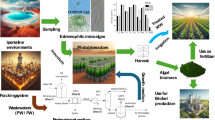Abstract
It is imperative to slash the cost of algal oil to less than $50 bbl−1 for successful algal biofuel production. Use of municipal wastewater for algal cultivation could obviate the need for freshwater and the nutrients—N and P. It would also add CO2 through bacterial activity. Chlorella minutissima Fott et Nova dominated the entire phycoflora year around and through each stage of the wastewater treatment at the oxidation pond system of Wazirabad (Delhi) in India. The ability to grow so profusely in such varied and contrasting situations made this alga unique. Besides pollution tolerance, it grew heterotrophically in dark under acidic conditions and as a mixotroph in presence of light over a range of organic C substrates. It could utilize both ammoniacal and nitrate nitrogen, survived anaerobicity, 5% NaCl and −10 bar of osmotic stress. C. minutissima grew at pH 4–11 and raised the pH set initially by 1 to 3 units in 7.5 h. It showed gigantism and largely kept afloat in presence of utilizable organic carbon, while flocculated in mineral medium and on aging. The alga also possessed potential for biofuel production. The studied parameters indicate why C. minutissima was a potential biomass builder in municipal sewage and could be used to determine which other alga(e) may serve the purpose.





Similar content being viewed by others
References
Benemann, J., & Oswald, W. (1996). Final report to the US Department of Energy, Grant No. DE-FG22-93PC93204. Pittsburgh Energy Technology Center.
Fahm, L. (1980). The waste of nations: The economic utilisation of human waste in agriculture. Montclair, New Jersey, USA: Allenhand, Osmun & Co. Pub, Inc.
Niemczynowicz, J. (1997). The water profession and agenda 21. Water Quality International, March/April: 9–11.
Bhatnagar, A. (1999). Journal of Environmental Biology, 20, 115–120.
Bhatnagar, A., & Bhatnagar, M. (2001). Innovative approaches in microbiology. In D. K. Maheshwari & R. C. Dubey (Eds.), India: Bishen Singh Mahendra Pal Singh, Dehra Dun, pp. 379–403.
Droop, M. R. (1967). British Phycological Bulletin, 3(2), 295–297.
Stanier, R. Y., Kunisawa, R., Mandel, M., & Cohen-Bazire, G. (1971). Bacteriological Reviews, 35, 171–205.
Porra, R. J., Thompson, A., & Friedelman, P. E. (1989). Biochimica et Biophysica Acta, 975, 384–394.
Lowry, O. H., Rosebrough, N. J., Farr, A. L., & Randall, R. J. (1951). Journal of Biological Chemistry, 193, 265–275.
Roe, J. H. (1955). Journal of Biological Chemistry, 212, 335–343.
Bligh, E. G., & Dyer, W. J. (1959). Canadian Journal of Biochemistry and Physiology, 37, 911–917.
Chinnasamy, S., Ramakrishnan, B., Bhatnagar, A., & Das, K. C. (2009). International Journal of Molecular Sciences, 10, 518–532.
Somogyi, M. (1945). Journal of Biological Chemistry, 160, 61–68.
Kumar, A., Tabita, F. R., & van Baalen, C. (1982). Archives of Microbiology, 133, 103–109.
Larslandner (1989). Advanced hazard assessment. In R. S. De Santo (Ed.), Springer Ser. Environmental management (pp. 223–225). Berlin, Germany: Springer-Verlag.
Cox, H. E., & Pearson, D. (1962). The chemical analysis of foods. New York, USA: Chemical Publishing Co. Inc.
Michael, B. E., & Kaufman, M. R. (1973). Plant Physiology, 51, 914–916.
Ogawa, T., & Aiba, S. (1981). Biotechnology and Bioengineering, 23, 1121–1132.
Abeliovich, A., & Weisman, D. (1978). Applied and Environmental Microbiology, 35(1), 32–37.
Day, J. D., Edwards, A. P., & Rodgers, G. A. (1991). Bioresource Technology, 38(2–3), 245–249.
Andrade, M. R., & Costa, J. A. V. (2007). Aquaculture, 264(1–4), 130–134.
Jeong, H. J., Du Yoo, Y., Kim, J. S., Kim, T. H., Kim, J. H., Kang, N. S., et al. (2004). Journal of Eukaryotic Microbiology, 51(5), 563–569.
Katechakis, A., Haseneder, T., Kling, R., & Stibor, H. (2005). Limnology and Oceanography, 50(4), 1290–1299.
Tittel, J., Bissinger, V., Gaedke, U., & Kamjunke, N. (2005). Protist, 156(1), 63–75.
Orus, M. L., Marco, E., & Martinez, F. (1991). Bioresource Technology, 38, 179–184.
Kremer, B. P. (1979). Journal of Phycology, 15, 244–247.
Raven, J. A., Johnson, A. M., & MacFarlane, J. J. (1990). Biology of the red algae. In: K. M. Cole and R. G. Sheath (Eds.), New York: Cambridge University Press, pp. 171–185.
Martinez, F., & Orus, M. I. (1991). Plant Physiology, 95, 1150–1155.
Turpin, D. H., Elrifi, I. R., Birch, D. G., Weger, H. G., & Holmes, J. J. (1988). Canadian Journal of Botany, 66, 2083–2097.
Kamiya, A., & Kowallik, W. (1987). Pl Cell Physiol, 28(4), 611–619.
Bagchi, S. N., Chauhan, V. S., & Palod, A. (1990). Current Microbiology, 21(1), 53–57.
Doucha, J., Straka, F., & Lívanský, K. (2005). Journal of Applied Phycology, 17, 403–412.
Rodolfi, L., Zittelli, G. C., Bassi, N., Padovani, G., Biondi, N., Bonini, G., et al. (2009). Biotechnology and Bioengineering, 102, 100–112.
Ueno, Y., Kurano, N., & Miyachi, S. (1998). Journal of Fermentation and Bioengineering, 86(1), 38–43.
Acknowledgment
Authors are grateful to the Dean, PG School, IARI, New Delhi and Biorefining and Carbon Cycling Program of the University of Georgia, Athens, GA, USA for providing financial and academic support for the study.
Author information
Authors and Affiliations
Corresponding author
Rights and permissions
About this article
Cite this article
Bhatnagar, A., Bhatnagar, M., Chinnasamy, S. et al. Chlorella minutissima—A Promising Fuel Alga for Cultivation in Municipal Wastewaters. Appl Biochem Biotechnol 161, 523–536 (2010). https://doi.org/10.1007/s12010-009-8771-0
Received:
Accepted:
Published:
Issue Date:
DOI: https://doi.org/10.1007/s12010-009-8771-0




